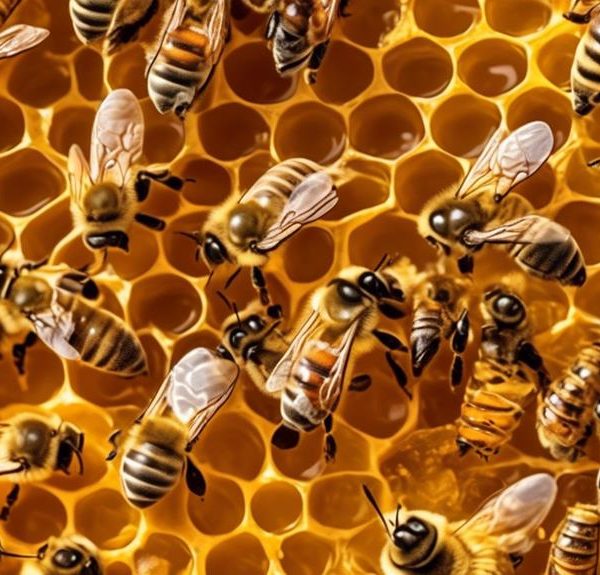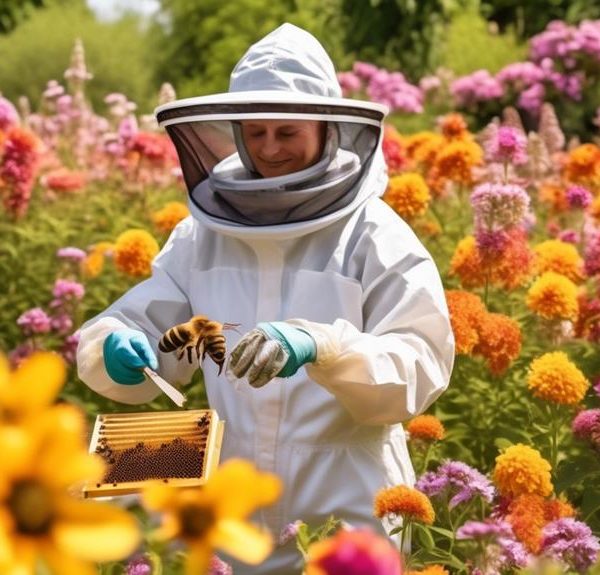Navigate the intricate world of candle wax, delving into the differences between beeswax and your everyday candle wax, and their unique impacts.
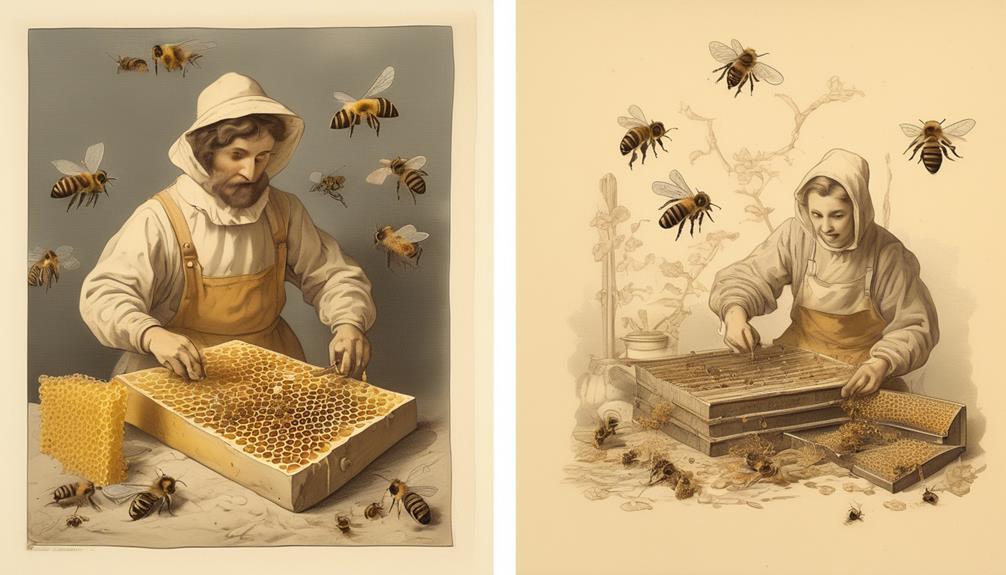
Is Beeswax the Same as Candle Wax?
In the old days, when the only source of light was the flicker of a candle, you might not have considered the type of wax that made up your candle. You're probably familiar with beeswax, a naturally occurring substance produced by honey bees, but is it the same as the wax used in candles? The answer isn't as straightforward as you might think, and while they share some characteristics, there are also significant differences.
So, why should you care about the wax in your candles? As we explore further, you'll find that the type of wax can impact everything from the way a candle burns to its environmental impact.
Key Takeaways
- Beeswax is a natural and sustainable wax option for candles, derived from honey production.
- Beeswax candles burn longer and cleaner than candles made from paraffin or soy wax.
- Beeswax has hypoallergenic properties and emits a subtle honey fragrance when lit.
- Beeswax is biodegradable and has a lower environmental impact compared to petroleum-based paraffin wax.
Understanding the Basics of Wax
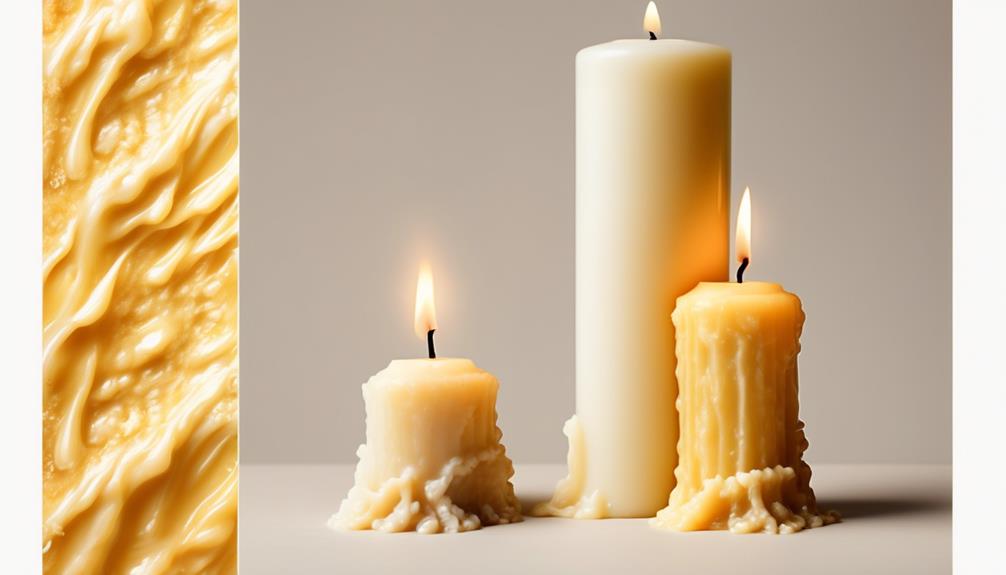
To fully comprehend the difference between beeswax and candle wax, it's crucial to first understand the fundamental properties and structure of wax itself.
Wax is a class of chemical compounds that are plastic (malleable) near ambient temperatures. It's composed of long-chain hydrocarbons that are primarily carbon and hydrogen atoms linked together in chains, with a slight possibility of a few oxygen atoms. These properties give wax its distinct characteristics: it's water-resistant, has a high melting point, and can be easily shaped.
Natural waxes, like beeswax, are formed from the metabolic processes of living organisms. Synthetic waxes, on the other hand, are artificially produced by refining petroleum. This is where the key difference lies.
Beeswax is a natural substance secreted by honeybees, which is used in constructing their honeycombs. It's purely organic, with a sweet scent and a golden hue.
Conversely, candle wax, often paraffin wax, is produced by distilling the residues left by crude oil refining. It's odorless and colorless, with a faint chemical smell.
Understanding this gives you a better grasp of the difference between beeswax and candle wax.
Key Characteristics of Beeswax
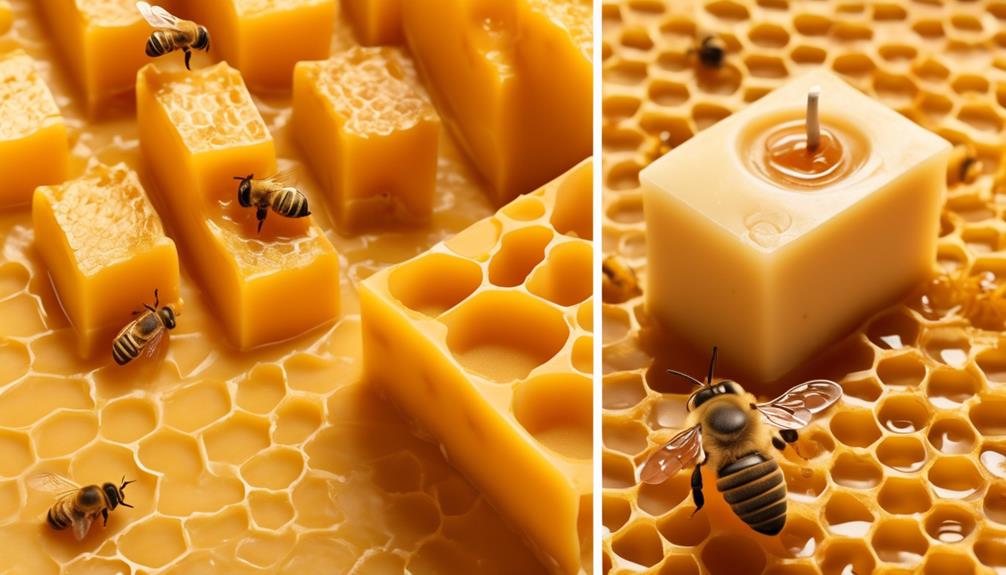
Diving into the unique characteristics of beeswax, you'll find it's not only renowned for its natural origin, but also for its superior burn quality, fragrance, and health benefits. Unlike paraffin or soy wax, beeswax is a natural byproduct of honey production, making it a sustainable and eco-friendly option.
You'll notice that beeswax candles burn longer and cleaner than their counterparts, with minimal soot production. This superior burn quality is due to the high melting point of beeswax, which means it doesn't burn away as quickly.
The natural scent of beeswax is another standout characteristic. When lit, it releases a subtle honey fragrance that's more authentic and less overpowering than synthetic scents. It's a natural air purifier, too. As beeswax burns, it emits negative ions that can neutralize pollutants in the air.
On the health front, beeswax is hypoallergenic, making it a great option for those with allergies or sensitivities. It's also free of harmful byproducts found in some candle waxes, like toluene and benzene.
Common Types of Candle Wax
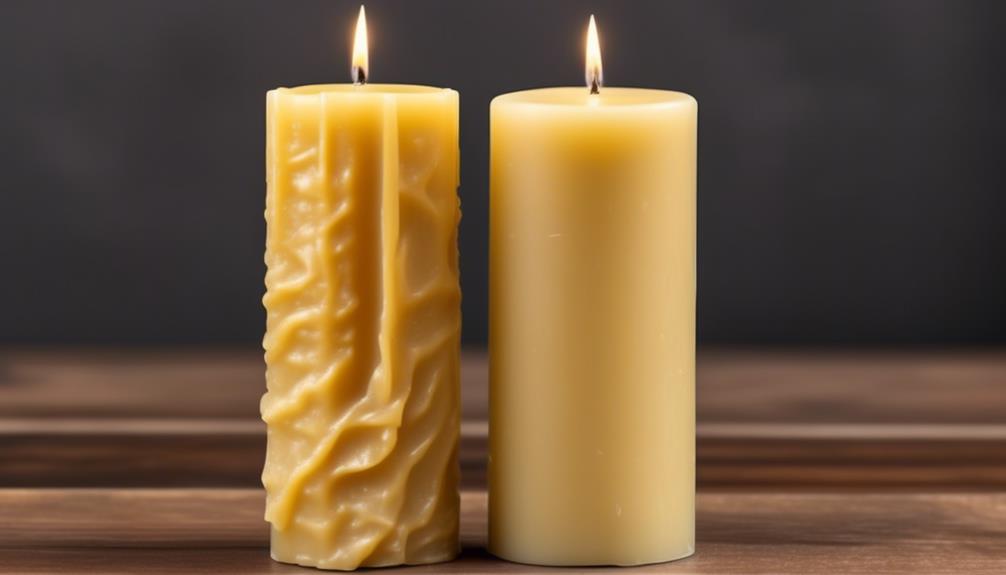
In the vast world of candle making, you'll find several types of wax, each with its unique characteristics and benefits. Let's delve into the most common ones.
Paraffin wax, a petroleum by-product, is widely used due to its cheap cost and ease of use. However, it's criticized for producing soot when burnt and potentially releasing toxic chemicals.
Soy wax, on the other hand, is a vegetable wax derived from soybean oil, boasting a cleaner burn and longer burning time than paraffin. It's eco-friendly but slightly pricier.
Beeswax, the product of industrious honeybees, is another option. It's natural, hypoallergenic, and emits a sweet, natural scent when burnt. It burns longer and cleaner than both paraffin and soy but commands a higher price.
Palm wax, made from palm oil, is a hard, long-burning wax that produces beautiful crystalline effects in candles. Its environmental impact, however, is a contentious issue due to deforestation concerns.
Lastly, there's coconut wax, a relatively new entrant that's made from high melt point coconut oil. It's renowned for its slow, clean burn, excellent scent throw, and eco-friendly nature. However, it's the most expensive option.
Comparing Beeswax and Candle Wax
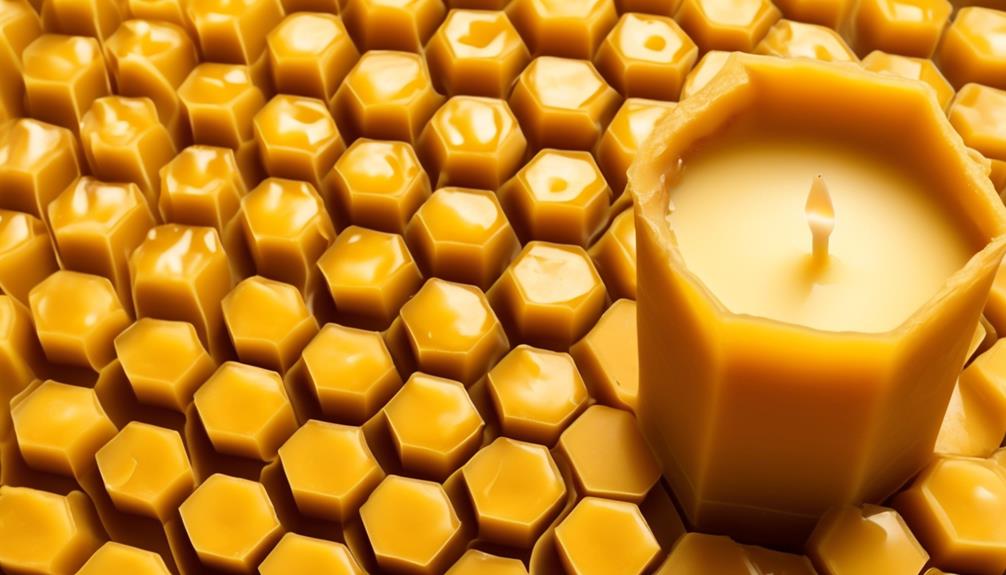
Let's examine and compare beeswax with other types of candle wax, considering factors such as burn time, scent, cost, and environmental impact.
Beeswax is renowned for its slow, clean burn. It outlasts paraffin and soy waxes, offering you more light and warmth for your buck.
The scent of beeswax holds a natural, honey-like aroma, which is often preferred over the artificial fragrances added to other waxes. You'll find this gentle scent can create a more relaxing and comfortable environment.
In terms of cost, beeswax is typically more expensive than paraffin or soy wax. However, when you factor in its longer burn time, you may find it's worth the extra investment.
Now, let's consider the environmental impact. Beeswax is a natural, renewable resource, produced by bees in the process of honey making. It's biodegradable and toxin-free, unlike paraffin wax, which is derived from petroleum and releases harmful chemicals when burnt.
Choosing the Right Wax for Your Needs
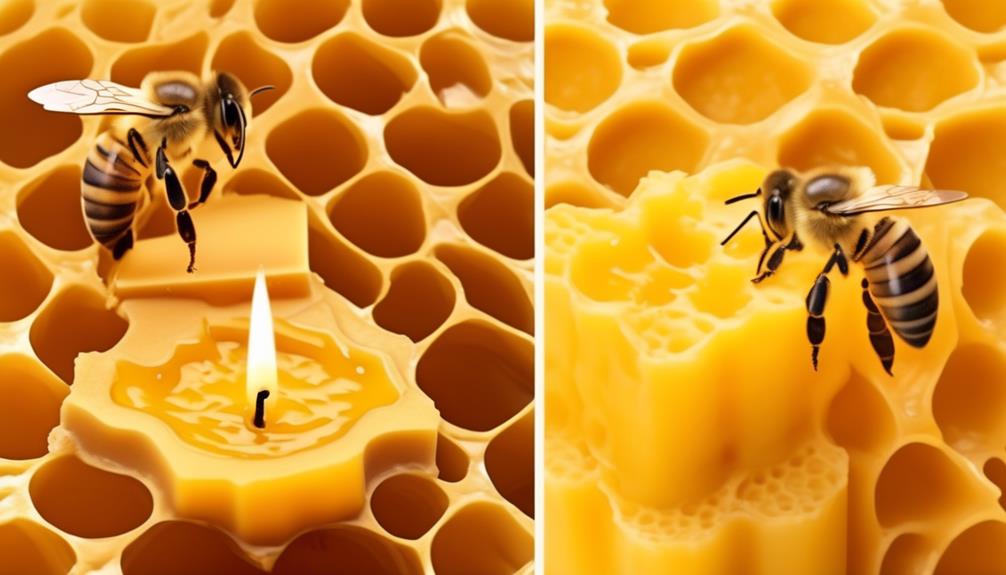
Your choice of candle wax should align with your specific needs and preferences, taking into account factors such as burn time, scent, cost, and environmental impact.
When considering burn time, beeswax reigns supreme. It has a slower burn rate compared to paraffin, the common candle wax, which means it'll last longer. If you're after a long-lasting, economical option, beeswax is your go-to.
Now, let's talk scent. Paraffin wax can be easily combined with various fragrances, making it ideal for scented candles. Beeswax, on the other hand, has a natural, sweet honey-like aroma. If you're sensitive to artificial fragrances, it's a perfect choice.
In terms of cost, paraffin is less expensive. Beeswax, however, is worth the investment due to its durability and natural properties.
Lastly, consider the environmental impact. Paraffin wax is petroleum-based, contributing to greenhouse gas emissions. Beeswax is a renewable resource, making it an eco-friendly alternative.
Frequently Asked Questions
How Is Beeswax Produced by Bees and Harvested for Use?
Bees produce beeswax by converting sugar from honey in their bodies and excreting it through glands on their abdomen. They use it to build their honeycombs.
You can harvest beeswax by removing the honeycomb from the hive and scraping off the cap. You'll then melt down the comb, strain out impurities, and let it cool to form a solid block.
That's your beeswax, ready for use in various applications.
Are There Any Environmental Considerations in Using Beeswax or Candle Wax?
Yes, there are environmental considerations when using beeswax or candle wax.
Beeswax is a natural, renewable resource, produced by bees. It's biodegradable and doesn't release toxins when burned. However, its collection can disturb bee populations.
Most candle wax is paraffin, a petroleum by-product. It's not renewable and releases soot and toxins when burned.
Soy and palm waxes are alternatives, but their cultivation can lead to deforestation.
Can Beeswax Be Used for Purposes Other Than Candle Making?
Yes, you can use beeswax for purposes other than candle making. It's often used in cosmetics like lip balm and lotion because it's a natural moisturizer.
Beeswax also serves as a main ingredient in furniture polish and even in food, as a coating or glaze.
It's a versatile substance that's not just limited to making candles.
How Does the Price of Beeswax Compare to Other Types of Candle Wax?
You're likely to find beeswax is more expensive than other types of candle wax. This cost difference stems from the natural and labour-intensive process of beeswax production. Unlike paraffin or soy waxes, which are more industrialized and easier to produce in large quantities, beeswax is sourced from beekeepers, which can drive up the price.
However, it's often preferred for its slow, clean burn and natural honey scent.
Do Beeswax Candles Produce a Different Type of Flame or Burn Time Compared to Other Candle Waxes?
Yes, beeswax candles do produce a different type of flame and burn time compared to other candle waxes. You'll find that beeswax candles burn brighter and longer. They emit a natural, subtle honey scent and don't produce smoke or soot.
They're also known to purify the air by releasing negative ions. So if you're looking for a longer-lasting, cleaner burning option, beeswax candles are a great choice.
Conclusion
In conclusion, beeswax isn't the same as candle wax. It's a natural product with unique characteristics, whereas candle wax can be derived from various sources, each with its own properties.
Choosing between them depends on your specific needs. If you value natural, hypoallergenic, and long-burning qualities, beeswax is ideal. However, if affordability, scent throw, and color variety are your priorities, a different type of candle wax may be more suitable.

